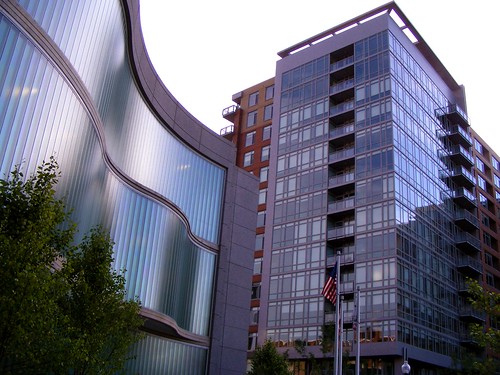
What are the ten densest neighborhoods in Montgomery County? The answers might surprise you. Find out on Thursday, but in the meantime, leave your guesses in the comments.
(I'm talking about population density, or the number of people per square mile. You might assume that the places with the tallest buildings or the worst traffic made the list, but you'd be surprised.)

1.dtss..
ReplyDeletenorth bethesda
wheaton
downtown rockville
forest glen
bethesda/bradley
hillandale/colesville
Not sure what "neighborhoods" entails.. there are the major city/town splits and then the several hundred much more specific areas
Can't wait to see the results!
:)
Yvette
the portion of langley park in moco?
ReplyDeleteI would guess that White Oak would be very dense. It doesn't have as many high rises as some of the other areas, but there are a lot of apartment complexes, condo developments, etc., and fewer single family homes. There's also not a lot of park land. (The large FDA complex takes up a lot of space, though, so that would work against it.)
ReplyDeleteThis might be a better topic once the 2010 Census numbers come out. The Census doesn't do a great job of estimates in rapidly redeveloping neighborhoods such as DTSS, Wheaton, White Flint, or Bethesda. Case in point: the Census says DTSS has actually LOST significant population since 2000, when we know for a fact that 1,000's of apartments and condos have been built in that time. Just sayin.
ReplyDeleteAnd by "estimates" I mean the Census' American Community Surveys. The question of what a "neighborhood" entails is also important. Measuring all of downtown Silver Spring and comparing it to Wheaton is unfair, considering how enormous DTSS is, and how probably most of the land area is actually commercial rather than residential. Comparing census tracts would be better, as you can combine and divide groups of tracts in order to get comparably-sized areas. However, this won't be possible until all of the 2010 Census data has been released.
ReplyDeleteDoes neighborhood = census-defined place? I would guess the surprising ones would be:
ReplyDeleteSome of the Chevy Chases
Some portions of Kensington
Leisure World (!)
And some not mentioned here:
Something in the Wheaton-Glenmont area (depending on how these are broken down)
Probably Gaithersburg and/or Montgomery Village and/or Germantown
Aspen Hill
Takoma Park
I wanted to use 2010 Census figures, but what I found from the 2005-2009 ACS was so intriguing that I couldn't wait. We'll return to this in a couple of months, I'm sure.
ReplyDeleteI used census tracts, which in some cases contain a portion of a neighborhood (meaning it's a more accurate depiction of density) or several neighborhoods (meaning it's less accurate if they're very different levels of density). So don't think about "downtown Silver Spring" but, rather, a neighborhood in downtown Silver Spring or anywhere else.
I can't remember exactly where I found the informatoin on the Census site, but they have released a State-by-State breakdown of population density (persons per square mile). Maryland was on the list, and was behind only the District and Massachusetts in terms of density. Maryland is, after all, one of the most urbanized states.
ReplyDeleteAspen Hill will definitely place high on the list, and possibly also will adjacent Layhill. Census's description of Aspen Hill is fairly accurate but I think that Layhill "census designated place" contains a lot of country-club estate housing. Glenmont is also likely to rank high in density. Twinbrook, also, I guess. Probably the Maryvale neighborhood in Rockville, etc.
Some contenders:
ReplyDeleteSligo Creek to Langley Park has around 12K in a couple small census tracts.
Downtown Silver Spring and over towards Grubb Road has about 9K.
The cores of Grovesnor, Bethesda, and Friendship Height each have about 4K in a small area.
The Lakeforest/Lost Knife/North Gaithersburg area has about 15K people in a pretty small area.
The part of Aspen Hill just south of Leisure World has 6K in a pretty small area.
One of the surprising ones - Briggs Chaney. It has about 7K.
The Lockwood area of White Oak and some clusters along New Hampsire north of Langley Park are also pretty dense.
Langley Park to Briggs Chaney via White Oak makes a lot more sense to me as a transit line than a line all the way down Colesville. Continuing that connection down to Fort Totten would present some challenges, though.
Just going to take a wild stab, in no particular order...
ReplyDeleteDTSS (not sure if the Blairs, or the condos along 16th Street count separately or not?)
White Oak/Lockwood (not sure where one ends and the next starts)
Glenmont
Leisure World
Kentlands
Long Branch
Langley Park
Germantown
Grosvenor/North Bethesda
Kingfarm
With the large amount of apartment complexes there, I would hazard a guess and say that Aspen Hill is right up there.
ReplyDeleteI LOVE the Leisure World thought...
ReplyDeleteI just checked newly released census data for the Silver Spring CDP and it says the population decreased over 5,000 since 2000...how does that make sense? Did the definition of what areas make up the CDP change? I feel like that's the only explanation....
ReplyDelete2010 data: http://factfinder2.census.gov/faces/tableservices/jsf/pages/productview.xhtml?pid=DEC_10_PL_GCTPL1.ST13&prodType=table
2000 data:
http://factfinder2.census.gov/faces/tableservices/jsf/pages/productview.xhtml?pid=DEC_00_PL_GCTPL.ST10&prodType=table
(links only worked for me in IE.)